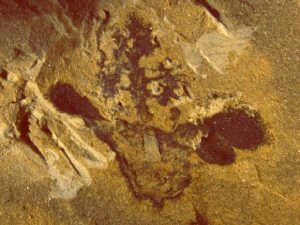 Flowering plants (called angiosperms) typically only appear in the upper fossil layers. Because of this, evolutionists assume they evolved from “simpler,” non-flowering plants (called gymnosperms). Gymnosperms do not make enclosed seed packets. A common example of gymnosperms is the conifers. Contrast the conifer’s cones, which just release the bare seed, to the packaging of nuts or sunflower seeds. Those have to be taken out of their tough container. Evolutionists have searched in vain for intermediate forms between the gymnosperms and the angiosperms. It has been a complete failure. Just recently, the first unequivocal flowering plant from before the Cretaceous (the time of the dinosaurs) was discovered in Jurassic rock layers of China (see picture). This pushes back the origin of flowers to much earlier than previously thought in the darwinian timeline…reducing the time available for evolution. As creationists, we believe that flowering plants generally occupied higher ground in the pre-Flood world. The gymnosperms typically dominated the lower swamplands where the dinosaurians lived. Those low-lying areas were buried first as the waves of the Genesis Flood began to come up onto the continents.
Flowering plants (called angiosperms) typically only appear in the upper fossil layers. Because of this, evolutionists assume they evolved from “simpler,” non-flowering plants (called gymnosperms). Gymnosperms do not make enclosed seed packets. A common example of gymnosperms is the conifers. Contrast the conifer’s cones, which just release the bare seed, to the packaging of nuts or sunflower seeds. Those have to be taken out of their tough container. Evolutionists have searched in vain for intermediate forms between the gymnosperms and the angiosperms. It has been a complete failure. Just recently, the first unequivocal flowering plant from before the Cretaceous (the time of the dinosaurs) was discovered in Jurassic rock layers of China (see picture). This pushes back the origin of flowers to much earlier than previously thought in the darwinian timeline…reducing the time available for evolution. As creationists, we believe that flowering plants generally occupied higher ground in the pre-Flood world. The gymnosperms typically dominated the lower swamplands where the dinosaurians lived. Those low-lying areas were buried first as the waves of the Genesis Flood began to come up onto the continents.
The Origin of Flowering Plants


